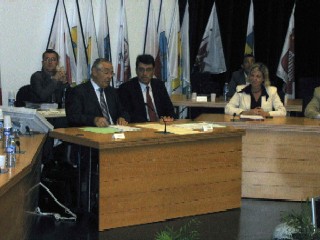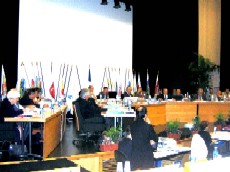In the monastic silence of the Linné Hall at Phoenix Park, the main actors of the Agglomeration gathered to discuss the major projects of the Community of Communes. In a general drowsiness, the first vice-president and Mayor of Cagnes-sur-Mer, Louis Nègre, opened the session. It was up to him to undertake the difficult task of presenting the Urban Mobility Plan (UMP) project.

Following this presentation, the 13th vice-president Hervé Paul corrected the course. He specified that the UMP will be adapted according to the particularity of the communes, which act as project managers. The Nice hills will see a different development than the localities on flat terrain.
The financial contribution will mainly come from CANCA, the General Council, the Regional Council, and the SYMITAM (Mixed Transport Syndicate of the Alpes-Maritimes). Whether users will follow the trend remains to be seen.
In sum, a budget envelope of 115 million euros over 8 years, unanimously adopted by the Community Council. Next, a public inquiry scheduled for March 2007.
Another crucial subject: the supplementary budget. Vice-president Henri Revel faced the painful fact without a grimace. CANCA is significantly in deficit compared to the initial budget. It needs an additional 193.5 million, mainly to cover transportation and sanitation expenses. The first item alone requires assistance of 32.4 million euros, which will likely be covered by the exceptional result of 32.9 million euros without resorting to borrowing.
The major allocations of the Supplementary Budget: the mobilization of 9.8 million euros for sanitation works, 3 million euros for drinking water network improvement works, 1.5 million euros for the development of a specific pricing system for students and youth, and 2.5 million euros for the purchase of land for the tramway and park-and-ride facilities.
Everything is being done to ward off the threat of debt, the bane of the Agglomeration. The Community Council is committed to performing as well as last year. In 2005, borrowing was mobilized to the extent of 60 million euros against a forecast of 173 million, while achieving the planned investments and self-financing them. “In the end, the expenses we incurred became revenues,” noted Henri Ravel. CANCA still represents a disparate ensemble today. It includes well-off communes and those that are lagging. To show that there is solidarity among each of the localities, subsidies will be distributed to help the most in need. La Trinité, for example, will receive an exceptional aid fund of 300,000 euros. “We will allocate money to maintain the integrity of all the communes,” promised the President of the Council and Senator-Mayor of Nice Jacques Peyrat.

The agreement provides for field actions by CANCA agents – environmental initiations, walks in the forest, by the water, etc. CANCA’s support gives a new dimension to raising environmental awareness among young audiences. “Without this aid, national education would have been content to print fact sheets and distribute them. Because this campaign represents a huge budget,” argued Michel Gazaglia, Community Councillor and principal of the Thierry Maulnier high school in Nice, somewhat provocatively.


